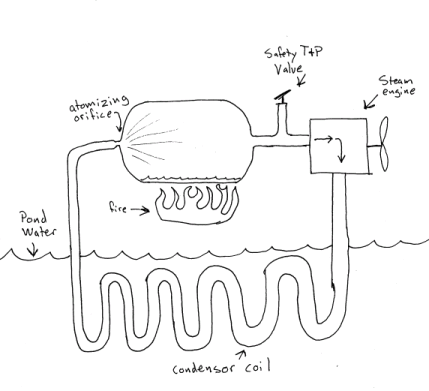I try not to think about Stirlings too much because I become obssessed. There seems to be enough recent talk about them though that I just have to say a few things. I think there was another post asking about stirling outputs that must have been deleted yesterday.
So when is it technically called a stirling engine? A stirling engine uses temperature differntial to produce motion. If you were to reverse the process and turn the flywheel by hand, you would be producing a temperature differential in the two cylinders. Sound familiar? It's a refrigeration cycle! A very inefficient refrigeration cycle  What would make it more efficient? How about some refrigerant! Maybe Stirling engines should be using refrigerant instead of air. Well, some of them do. Of course, not many of us can build a stirling engine and pump it full of R-410 but maybe some more volatile liquids, like alcohol, could still be used.
What would make it more efficient? How about some refrigerant! Maybe Stirling engines should be using refrigerant instead of air. Well, some of them do. Of course, not many of us can build a stirling engine and pump it full of R-410 but maybe some more volatile liquids, like alcohol, could still be used.
So is my airconditioner a stirling engine just waiting to be turned in reverse? No, airconditioning compressors aren't good for anything but the refrigeration loop that they were spec'd for. But what if we replaced the compressor with some kind of simple motor? Is that a Stirling?
I also like steam engines. I wanted to build a tiny steam engine that could propell a small rowboat at a very slow speed. I thought it would be nice to light a few coals under a small boiler, lay down in the boat, and slowly putt putt across the pond. I started out trying to figure out a way to syphon pond water into the boiler but wound up with something that looked like a refrigeration loop again. It's a closed loop boiler that condenses the exhaust steam and reuses it. Here's a rough sketch, I don't remember all of the details.

The loop is filled with enough water to reach the atomizing orifice. With enough pressure the cold water will enter the boiler in a spray thereby picking up heat quickly. If the boiler is hot enough the spray will turn directly to steam. The safety temperature and pressure valve should eventually let enough steam out to balance the system and prevent explosion. The steam engine in this picture should probably be elevated a little bit. Having a large body of water, like a pond, is what makes the condensor coil practical. The atomizing orifice should create enough back pressure to ensure that the flow continues in the correct direction.
So what is this? A steam engine with a closed loop boiler, or a stirling cycle?
I imagine a lot of people that are interested in Stirlings on this board are attracted because of the ability to use solar energy. I see that someone is trying to couple a generator to a solar chimney. Stirling cycle again? Anyway, the problem with using solar in a stirling cycle is the lack of phase change. To solve this, you either need to come up with a way to produce high enough heat with solar to vaporize a liquid or you need to come up with a liquid that will vaporize at a lower temperature.
I think that displacement type stirlings are toys. In order to build something that can really do some work you need a piston type engine and a better refrigerant than air.